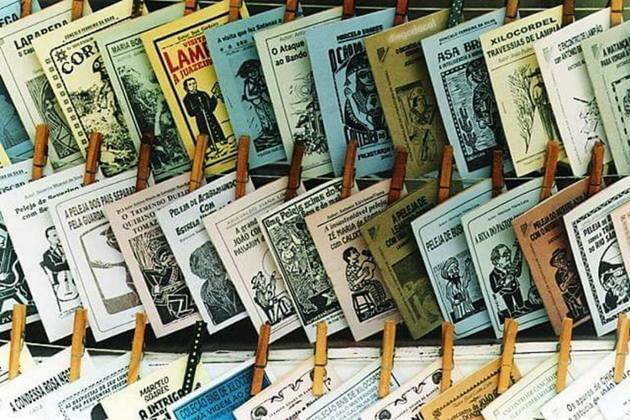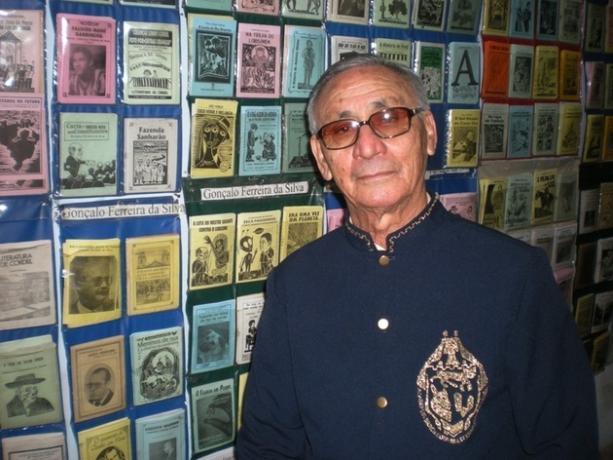THE Literature of twine it is a traditional literary manifestation of Brazilian popular culture, more precisely from the interior of the Northeast.
The places where it has great prominence are the states of Pernambuco, Alagoas, Paraíba, Pará, Rio Grande do Norte and Ceará. For this reason, the northeastern cordel is one of the most outstanding in the country.
In Brazil, Cordel's literature gained strength in the 19th century, especially between 1930 and 1960. Many writers were influenced by this style, among which the following stand out: João Cabral de Melo Neto, Ariano Suassuna and Guimarães Rosa.
string origin
The term “Cordel” is of Portuguese heritage. This artistic expression was introduced by them in Brazil at the end of the 18th century.
In Europe, it began to appear in the 12th century in other countries (France, Spain and Italy) and became popular in the Renaissance period.
In its origin, many poets sold their works in city fairs. However, with the passage of time and the advent of radio and television, its popularity declined.
Main characteristics of cordel literature
- Regional literary tradition;
- Opposed to traditional literature;
- Literary genre in verse;
- Popular themes and Brazilian popular culture;
- Popular, oral, regional and informal language
This type of manifestation has as main characteristics the orality and the presence of elements of Brazilian culture. Its main social function is to inform, while entertaining readers.
As opposed to traditional literature (printed on books), cordel literature is a regional literary tradition.
Its most common form of presentation are “leaflets”, small books with woodcut covers that hang on string or rope, and hence its name.

Cordel literature is considered a literary genre generally done in verses. It departs from canons insofar as it incorporates popular language and themes.
In addition, this manifestation resorts to other means of dissemination, and in some cases, the authors themselves are the promoters of their poems.
Regarding language and content, cordel literature has the following main characteristics:
- Colloquial language (informal);
- Use of humor, irony and sarcasm;
- Various themes: Brazilian folklore, religious, secular, political, historical episodes, social reality, etc.;
- Presence of rhymes, meter and orality.
Top brazilian cordelists
The authors of cordel literature are called "cordelistas". According to current surveys, it is estimated that there are around 4000 artists in activity in Brazil, of which the following stand out:
- Apolônio Alves dos Santos
- blind aderaldo
- Cuica de Santo Amaro
- Guaipuan Vieira
- Firmino Teixeira do Amaral
- João Ferreira de Lima
- João Martins de Athayde
- Manoel Monteiro
- Leandro Gomes de Barros
- José Alves Nephew
- Homer of Rego Barros
- Patativa do Assaré (Antônio Gonçalves da Silva)
- Teo Azevedo
- Gonçalo Ferreira da Silva
- John of Christ the King
You may also be interested in:
- Arian Suassuna
- João Cabral de Melo Neto
- Guimaraes Rosa
Examples of string poems
1. Excerpt from “Proezas de João Grilo”, by João Martins de Athayde
john c. was a christian
that he was born before the day
created without beauty
but he had wisdom
and died after hours
for the arts she did.
And was born from seven months
cried in her mother's stomach
when she caught a cat
he yelled: don't scratch me
don't play on this animal
that you might not win.
the night John was born
there was an eclipse on the moon
and detonated a volcano
that still goes on
that night ran
a werewolf on the street.
But João Grilo was created
small, thin and sambudo
the spindly and thin legs
and big mouth and lips
in the place where I lived
gave news of everything.
2. Excerpt from “O Fiscal ea Lagarta” by Leandro Gomes de Barros
One day there was a caterpillar
under a foot of smoke
when he looked up
Saw a consumer inspector.
Said the caterpillar to him:
I mess up today
the inspector asked soon
Insect, what are you gnawing?
the caterpillar asked him
Tax, what are you doing?
—Aperriating the commerce
Taking everything and eating.
The inspector said: for the tax
the government appoints me
the caterpillar answered him
What you need is jail,
to lose the habit
From stealing socks.
The inspector said: the government
Can't keep up,
without looking for the tax
From whom to buy and sell,
artist and farmer
They pay for just duty.
3. Excerpt from “Peleja do Cego Aderaldo with Zé Pretinho dos Tucuns”, by Firmino Teixeira do Amaral
Enjoy, my readers,
A strong discussion,
I had with Zé Pretinho,
A sertão singer,
Which, in the tangent of the verse,
Any question won.
One day I determined
Leaving Quixadá —
one of the beautiful cities
From the state of Ceará.
I went to Piauí,
See the singers from there.
I stayed at Pimenteira
Then in Alagoinha;
I sang in Campo Maior,
At Angico and at Baixinha.
From there I got an invitation
To sing at Varzinha.
When I arrived at Varzinha,
It was in the morning, very early;
So, the owner of the house
He asked me without affection:
— Blind, you're not afraid
The fame of Zé Pretinho?
I told him, "No, sir,
But the truth is I don't mock!
Call this nigger,
That I want to give it a tumble —
him arriving, one of us
The loin will burn today!
Brazilian Academy of Cordel Literature
The Brazilian Academy of Cordel Literature (ABLC) gathers around 7,000 documents, ranging from research, books and cordel pamphlets. Founded in 1989, it is located in the Santa Teresa neighborhood in Rio de Janeiro.

The purpose of this literary entity is to rescue the memory of cordel literature, bring together the exponents and deepen research on this popular manifestation.
Learn more about Brazilian folklore.
string literature and suddenly
Cordel literature and the surprise are two distinct popular and cultural manifestations. Although they are similar, each one has its peculiarities.
- O suddenly, made by the repentistas, is based on spoken and improvised poetry, usually accompanied by musical instruments.
- O twine, written by cordelistas, is popular poetry, with traces of orality disclosed in leaflets.
At fairs in the past and with the intention of selling their art, cordelistas used creativity techniques to attract the public.
From that point on, poetry was recited (and sometimes accompanied by viola, tambourine, etc.) and dramatized in public places as a way of awakening the interest of the population. It was precisely this fact that generated a lot of confusion regarding the suddenness.
See also other popular literary manifestations:
- What is it, what is it: riddles with answers
- super difficult tongue twisters
- Parlendas of Brazilian Folklore
- Most Popular Proverbs and Sayings in Brazil
- Legends and Characters of Brazilian Folklore
- Northeastern Folk Legends You'll Love
- Unmissable Legends of the South Region
- The exciting story of the açaí legend
- Source of popular expressions you need to know



